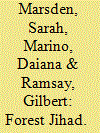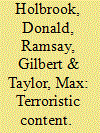| Srl | Item |
| 1 |
ID:
132226


|
|
|
|
|
| Publication |
2014.
|
| Summary/Abstract |
Despite increasing concern over the potential threat from "forest jihad," there has been no systematic attempt to assess whether such attacks are in fact taking place. Drawing on principles from the geospatial profiling of terrorist events, fire-risk prediction data, and information on jihadist convictions, this article offers a thorough review of the evidence to address this question. The available information suggests that so far, jihadists have not attempted to attack North American or European wildlands by means of arson. Despite calls for "popular resistance terrorism" in the jihadist literature, and the apparently low costs associated with this type of attack, jihadists have so far shown little appetite for "forest jihad."
|
|
|
|
|
|
|
|
|
|
|
|
|
|
|
|
| 2 |
ID:
189343


|
|
|
|
|
| Summary/Abstract |
Despite great interest in the importance of “narrative” to the global jihadi movement, research on actual examples of jihadi storytelling has been very limited to date. In this paper, I discuss the phenomenon of jihadi storytelling, specifically in digital contexts, focusing on the case study of one storyteller in particular: “Najm al-Din Azad”, a Saudi jihadist who tweeted and blogged a collection of “Tales of the Heroism of the Mujahidin” while participating in the Syrian civil war.
|
|
|
|
|
|
|
|
|
|
|
|
|
|
|
|
| 3 |
ID:
120327


|
|
|
|
|
| Publication |
2013.
|
| Summary/Abstract |
In this article we offer a first attempt at providing a set of universal grading criteria for determining on what basis, and how far, an item of discursive content can be considered "terroristic." In doing so, we draw loosely on the existing COPINE scale for child abuse images. The scale described in the article is not intended to reflect actual risk of engagement in terrorist violence, nor is it intended to have evidential validity in relation to offenses in certain jurisdictions relating to "terrorist publications." Rather, by formalising assumptions which seem already to be latent in the literature on terrorist use of the Internet, it aspires to serve as a starting point for a more methodologically coherent approach to relationships between content-particularly online content-and terrorism.
|
|
|
|
|
|
|
|
|
|
|
|
|
|
|
|